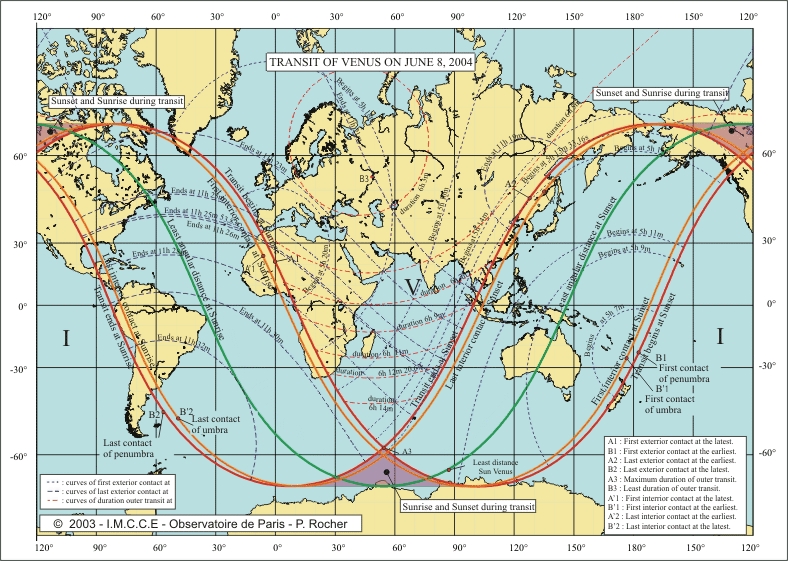

Venus Transit 2004
... Observing Partners
Introduction
Many observers will be satisfied by sending their observations to the VT-2004 Observing Campaign interface site. Here they will be used - together with all the others received - to determine the distance to the Sun (the Astronomical Unit) - the details are explained on this page.
Finding Observing Partners
Some observers are looking for "Observing Partners", i.e. other observers, mostly at very different geographical locations. They want to compare their own data (timings) with those obtained at the other site, in order to make a determination of the Astronomical Unit on the basis of the two data sets. This is indeed possible - the (small) differences in the timings reflect the geometry of the Venus transit and, if the observations at both sites are done well, may indeed lead to reasonably good results.
But how do you find partner observers? Where should they optimally be located and where may you look for them? Here is some useful information.
Methods of calculation and the choice of partners
The IMCCE in Paris has set up a webpage (in French) that describes in some detail how the optimum choice of partners depends on the method of calculation. Here is a short summary in English:
Three main calculation methods exist to determine the distance to the Sun (i.e., the solar parallax) by combining measurements of a Venus Transit, obtained at two different geographical locations:
- Halley's method : by comparison of the time intervals it takes Venus to cross the solar disk, as observed from the two sites. The larger the difference between the two time intervals, the more accurate will be the determination of the Astronomical Unit by this method. This happens when the two sites are as far apart as possible in geographical latitude, e.g., when one site is far North and the other is far South. The drawback of this method is that both sites must observe both contacts - this might easily fail, for instance if the weather deterioates at one of the sites, making it impossible to time the last contact from there.
- Delisle's method : by observing the times of the same contact (normally one or both of the interior (2nd or 3rd) contacts) from the two sites; the difference of the two timings can then be determined. This avoids the problem of changing weather conditions. In the past, the accuracy of this method was limited by the need to know the geographical positions of the two sites with high precision; nowadays, this is no longer a problem. Here, it is important that the time difference for the same contact is the largest possible; this is the case when the observers are as far as possible apart in the East-West direction. The partner should therefore be located at very different geographical longitudes.
- by obtaining simultaneous photos of Venus' disc from the two sites ; the slight shift of position on the two photos reflects the different lines-of-sight from the two sites and allows to compute the AU. The further the two sites are apart, the larger will be the shift of Venus' black disc on the solar surface and the better is the achievable accuracy. Here it is therefore the geographical distance that is the most important. Measurements of this type will profit greatly from the easy-to-use image processing facility set up at the Ondrejov Observatory (The Czech Republic) where you may submit your images and have a variety of well documented operations performed on them.
The above map shows where the Venus Transit on June 8, 2004, is visible. It also indicates the duration of the transit, as well as the beginning and end (UT) at different locations. This information is useful for the choice of "Observing Partners", as explained above. Click on the map to get a large image.
A List of Potential Partners
With the above considerations in mind, you may now consult the list of registered observers who have asked that their email address and geographical coordinates be made public, exactly for the purpose of finding observing partners.
You may of course also announce your search for an observing partner via the VT-2004 Forum as several observers have already done, but the chances may be less here.
The Calculations
For the calculation os the Astronomical Unit, you may consult Extended InfoSheet B4. It will also be very useful (and simpler) to use the forms at this page with approximate formulae.
Access to the Timings Data Base (after June 8, 2004)
After the Day of the Transit, registered observers will be given access to the entire set of observational data in the timings database (but NOT to the associated personal data!) . By combining timings obtained at different geographical sites, they will then be able to compute themselves the Astronomical Unit as described above.
Questions?
If you have questions in this connection, please do not hesitate to contact the organisers via email at vt-2004@eso.org.

